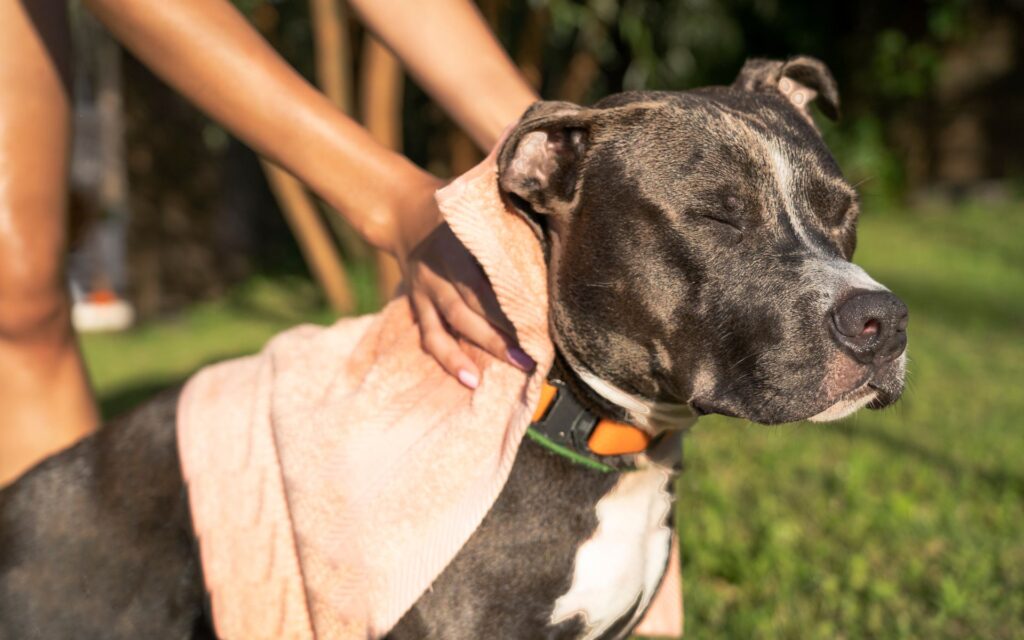Just like us, dogs can also have dry, itchy skin that needs extra care. Whether it’s caused by weather changes, allergies, or grooming products, dry skin can leave your dog feeling uncomfortable.
But don’t worry! There are simple, safe, and effective ways to moisturize your dog’s skin and keep their coat healthy and shiny.
Discover natural remedies, easy tips, and best practices to help soothe dryness and give your pup the comfort they deserve. Let’s get started!

Identifying Signs of Dry Skin in Dogs
Dry skin in dogs can cause discomfort, and it’s important to see the signs early. In the text below, we will discuss some common symptoms and give you advice on when to consult a vet.
Common Symptoms
Dry skin in dogs can show up in different ways. Here are some common signs to look out for:
- Flaky or scaly skin: You might notice white flakes, similar to dandruff, on your dog’s fur or bedding.
- Redness or irritation: Dry areas can become inflamed, making the skin look red or irritated.
- Excessive scratching, licking, or biting: If your dog is constantly trying to relieve itching, it could be because of dry skin.
- Hair loss or thinning fur: Patches of hair may fall out or look thin in areas where the skin is dry.
- Crusty patches or sores: In serious cases, dry skin can crack, which leads to sores or scabbing.
When to Consult a Veterinarian
Mild dry skin can often be treated at home, but in some situations, your dog might need professional help.
If you’ve tried moisturizing your dog’s skin and the problem continues, it would be good to call the vet. Also, if their skin is cracked and leads to sores, it can get infected and should be checked by a vet.
If you see your dog scratching, licking, or biting nonstop, it may be dealing with something more serious, like allergies or a skin condition. Dry skin could also be a symptom of an underlying health issue, especially if your dog is less active or not their usual self. Another thing you need to pay attention to is foul odor or discharge because these could indicate infections that need immediate attention.
Effective Methods to Moisturize Your Dog’s Skin
Keeping your dog’s skin moisturized doesn’t have to be complicated. Here are some simple and effective methods to moisturize your dog’s skin and improve their overall well-being:
1. Regular Brushing
Brushing your dog’s fur regularly helps remove dead skin cells, distributes natural oils, and prevents tangles. It also boosts circulation, promoting healthier skin and coat. Depending on your dog’s breed and coat type, brushing a few times a week or even daily can make a big difference.
2. Bathing Practices
Bathing your dog too often can strip their skin of essential oils, leading to dryness. Use a gentle, moisturizing dog shampoo and bathe your dog only when necessary—usually once a month or as needed. It would also be good to use a conditioner to help lock in moisture.
3. Humidifier Use
Dry air can make your dog’s skin even drier, especially in winter. Using a humidifier in the rooms where your dog spends time can help maintain moisture in the air, and that prevents their skin from becoming too dry.
4. Dietary Supplements
A healthy diet is very important for your dog’s skin health. You can add omega-3 fatty acids or fish oil supplements to their food. These nutrients help support skin hydration from the inside out, making their coat softer and shinier.
5. Topical Treatments
There are many dog-friendly moisturizers available, such as oils and sprays made with natural ingredients like aloe vera, coconut oil, or oatmeal. If you apply these products directly to dry areas, they can soothe the skin and provide immediate relief. Be sure to choose products specifically designed for dogs (not humans) to make sure they’re safe.
Natural Remedies for Dry Skin
Natural remedies can be a gentle and effective way to treat your dog’s dry skin. Many of these remedies use simple, safe ingredients you may already have at home. If you prefer using natural solutions, here are some options for moisturizing your dog’s skin:
1. Coconut Oil
Coconut oil is a popular natural remedy for dry skin. It has moisturizing properties and can help soothe irritation. You can put a small amount directly into your dog’s dry skin, or you can add it to their food to help hydrate their skin from the inside. Just try not to overdo it, because too much coconut oil can cause an upset stomach.
2. Oatmeal Baths
Oatmeal is known for its soothing and anti-inflammatory properties. Giving your dog an oatmeal bath can help relieve itching and irritation caused by dry skin. You can use oatmeal-based dog shampoos or grind plain oats into a fine powder and add it to warm bathwater. Let your dog soak for 10–15 minutes, then gently towel dry.
3. Aloe Vera
Aloe vera is another natural remedy that can calm and hydrate dry skin. The gel from an aloe vera plant is cooling and can help reduce redness or inflammation. Simply put a small amount of pure aloe vera gel in the affected areas. Just make sure your dog doesn’t lick it off because ingesting aloe vera can be harmful.
Preventative Measures
Prevention is key when it comes to keeping your dog’s skin healthy and moisturized. By following our advice below, you can reduce the risk of dryness and irritation. Here are some preventative measures to help maintain your dog’s skin health:
1. Balanced Diet
As we mentioned above, a well-balanced diet rich in essential fatty acids, vitamins, and minerals is important for your dog’s overall health, including their skin. High-quality dog food that includes omega-3 and omega-6 fatty acids can help support healthy, moisturized skin. If you’re unsure about their diet, ask your vet for recommendations.
2. Regular Grooming
Regular grooming is not only important for keeping your dog’s coat clean and tangle-free but also helps maintain skin health. Brushing your dog’s fur helps spread natural oils across their skin, which prevents dryness and keeps their coat shiny. Regular baths (without overdoing it) and trimming can also reduce the risk of skin problems.
3. Environmental Adjustments
Make your dog’s living environment as comfortable as possible. If you live in a dry climate or during colder months, you can use a humidifier. Don’t let your dog be in direct sunlight for too long, and keep their sleeping area warm and dry.
When to Seek Professional Help
If your dog’s dry skin doesn’t improve with home treatments or if you notice any of the following signs, it’s important to contact a vet:
- Persistent symptoms: If your dog continues to scratch, bite, or lick excessively even though you are using moisturizing or natural remedies, it could indicate an underlying issue.
- Signs of infection: Open sores, pus, or foul-smelling discharge could be signs of a skin infection that requires medical treatment.
- Severe discomfort: If your dog seems to be in pain, overly sensitive to touch, or unusually lethargic, this could be a sign of a more serious health issue.
- Hair loss or bald patches: If your dog is losing large amounts of fur or developing bald spots, it could indicate a condition like mange, allergies, or hormonal imbalances.
- Changes in behavior or appetite: If you notice changes in their behavior, eating habits, or energy levels, it may mean there is a serious health condition.
Conclusion
Taking care of your dog’s skin is important for their comfort and overall health. By recognizing the signs of dry skin and using simple remedies, you can help keep their coat healthy and moisturized. Regular grooming, a balanced diet, and environmental adjustments can help in preventing dryness. If your dog’s dry skin doesn’t improve or it becomes worse, it’s always a good idea to take them to a vet.
RELATED: Doberman Skin Issues: Common Skin Issues and Solutions



